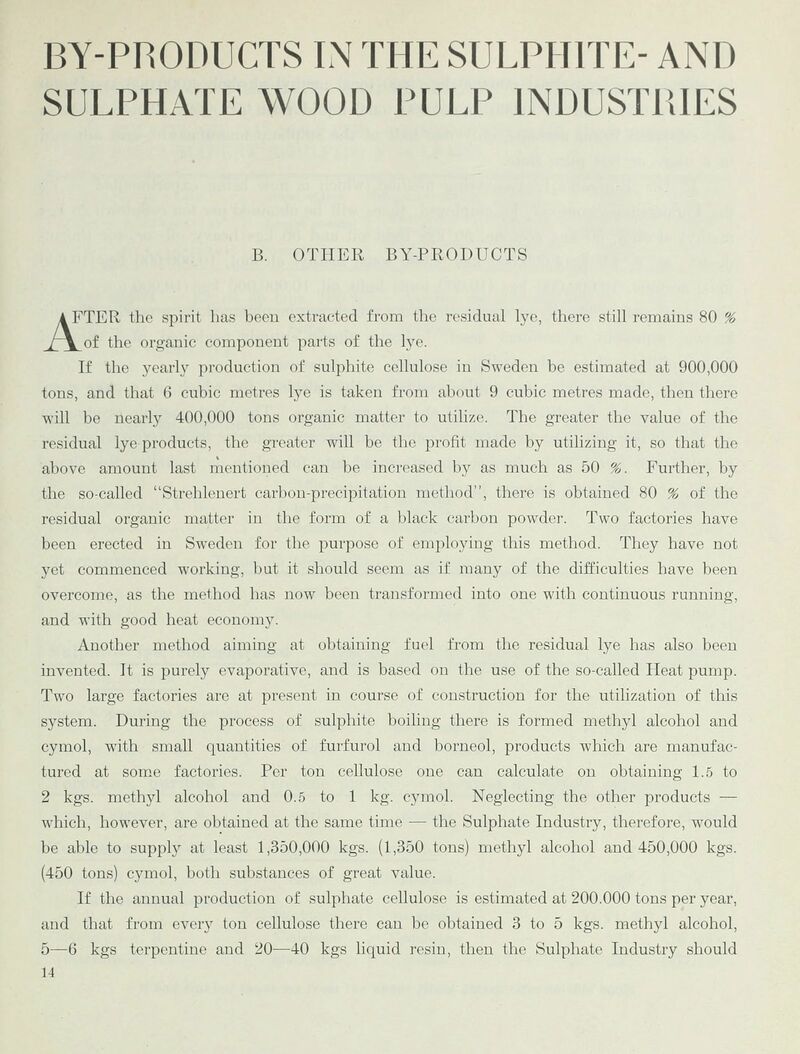
Full resolution (JPEG) - On this page / på denna sida - By-products in the sulphite and sulphate wood pulp industries

<< prev. page << föreg. sida << >> nästa sida >> next page >>
Below is the raw OCR text
from the above scanned image.
Do you see an error? Proofread the page now!
Här nedan syns maskintolkade texten från faksimilbilden ovan.
Ser du något fel? Korrekturläs sidan nu!
This page has never been proofread. / Denna sida har aldrig korrekturlästs.
BY-PRODUCTS IN THE SULPHITE- AND
SULPHATE WOOD PULP INDUSTRIES
B. OTHER BY-PRODUCTS
A FTER the spirit lias been extracted from the residual lye, there still remains 80 %
f \ of the organic component parts of the lye.
If the yearly production of sulphite cellulose in Sweden be estimated at 900,000
tons, and that 6 cubic metres lye is taken from about 9 cubic metres made, then there
will be nearly 400,000 tons organic matter to utilize. The greater the value of the
residual lye products, the greater will be the profit made by utilizing it, so that the
i
above amount last mentioned can he increased by as much as 50 %. Further, by
the so-called “Strehlenert carbon-precipitation method”, there is obtained 80 % of the
residual organic matter in the form of a black carbon powder. Two factories have
been erected in Sweden for the purpose of employing this method. They have not
yet commenced working, hut it should seem as if many of the difficulties have been
overcome, as the method has now been transformed into one with continuous running,
and with good heat economy.
Another method aiming at obtaining fuel from the residual lye lias also been
invented. It is purely evaporative, and is based on the use of the so-called Heat pump.
Two large factories are at present in course of construction for the utilization of this
system. During the process of sulphite boiling there is formed methyl alcohol and
cymol, with small quantities of furfurol and borneol, products which are
manufactured at some factories. Per ton cellulose one can calculate on obtaining 1.5 to
2 kgs. methyl alcohol and 0.5 to 1 kg. cymol. Neglecting the other products —
which, however, are obtained at the same time — the Sulphate Industry, therefore, would
be able to supply at least 1,350,000 kgs. (1,350 tons) methyl alcohol and 450,000 kgs.
(450 tons) cymol, both substances of great value.
If the annual production of sulphate cellulose is estimated at 200.000 tons per year,
and that from every ton cellulose there can be obtained 3 to 5 kgs. methyl alcohol,
5—6 kgs terpentine and 20—40 kgs liquid resin, then the Sulphate Industry should
14
<< prev. page << föreg. sida << >> nästa sida >> next page >>